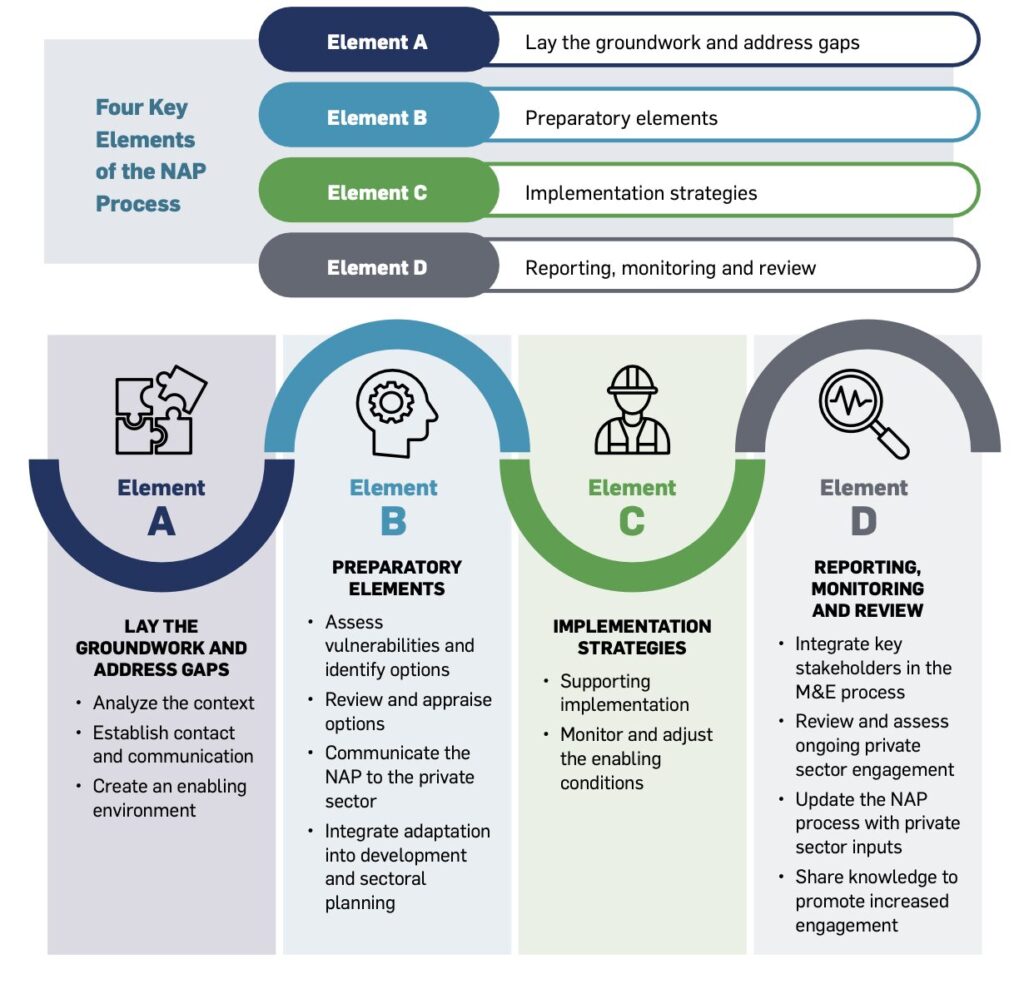Toolkit for engaging the private sector in National Adaptation Plans (NAPs)

Introduction
Established under the Cancun Adaptation Framework, the National Adaptation Plan (NAP) process provides a means for governments to identify their medium- and long-term adaptation needs and to develop subsequent strategies and programs to address them (UNFCCC, 2019). Included in this are processes whereby countries assess their climate vulnerabilities and mainstream climate risks and adaptation actions into their broader development plans and processes. Though the NAP process remains a government-led and country-owned process, an effective NAP process is inclusive, participatory, and should involve a variety of stakeholder groups, including the private sector.
This toolkit aims to help governments develop strategies for the effective engagement of private sector actors in the NAP process. It is intended as a guiding document and is not prescriptive; what works in one context may not work in another, and, as such, users should adopt those methods and approaches most relevant to their national or local realities. Users should also exercise discretion on which aspects of their NAP process would benefit from private sector engagement (such as consultations on prioritizing and financing adaptation actions) and those areas where private sector engagement is not necessary (such as discussions around integrating adaptation into ministerial budgets).
It is hoped that by engaging the private sector in adaptation planning, implementation, monitoring, and evaluation, governments will strengthen their response to the impacts of climate change and further build the resilience of their population.
This article is an abridged version of the original text, which can be downloaded from the right-hand column. Please access the original text for more detail, research purposes, full references, or to quote text.
Methodology
This toolkit was prepared by the International Institute for Sustainable Development, which hosts the NAP Global Network Secretariat, and the Adaptation Committee of the UNFCCC. It also greatly benefited from the input of experts at Deutsche Gesellschaft für Internationale Zusammenarbeit (GIZ) and Winrock International.
The toolkit is built upon the UNFCCC’s LEG Technical Guidelines for the NAP Process (2012) and builds on the NAP Global Network’s report, Engaging the Private Sector in National Adaptation Planning Processes (Crawford & Church, 2019).
It was developed through extensive research and consultation with private sector actors and experts in the field, as well as through examining preliminary experiences in the development of national strategies for engaging the private sector in the NAP process.
Engaging the private sector in the NAP process
Private sector actors are diverse and multi-faceted, and, as such, they have a variety of motivations for engaging in climate change adaptation. For some, adaptation action may be motivated by the search for profit and new markets or by the desire to reduce business risks; for others, it may be in response to policies, regulations, or signals from investors. Different actors will have different risk and capacity profiles that affect their willingness and ability to invest their own funds in developing new markets or tools that support climate adaptation (United Nations Environment Programme Finance Initiative [UNEP FI] et al., 2016).
Private sector actors differ in size (micro, small, medium, and large) and sectors. They can include large, publicly listed companies; micro, small, and medium-sized enterprises (MSMEs); private financiers and investors; insurance companies; and private foundations. This report divides the private sector into two general groups: private enterprises and private financiers.
Why Should Governments Engage the Private Sector in the NAP Process?
- Private sector actors can be a source of finance for adaptation options;
- Private sector actors can implement adaptation options;
- In many cases, private sector actors are already working on adaptation efforts;
- Effective stakeholder participation is central to the NAP process.
Why Should the Private Sector Engage in the NAP Process?
- Engagement can support the management of climate risks;
- Adaptation can present new opportunities for products and services;
- Action on adaptation can demonstrate an actor’s genuine concern for the environment while strengthening reputation and brand value;
- Compliance with regulations, laws, and investor preferences may necessitate action on adaptation.
Engaging the Private Sector: Key steps
The LEG’s Technical Guidelines for the NAP Process (UNFCCC, 2012) recommend four stages
of the NAP process to plan, implement, monitor, and evaluate adaptation.

The four keys elements of the NAP process: A – Lay the groundwork and address gaps; B – Preparatory elements; C – Implementation strategies; D – Reporting, monitoring and review.
Element A: Lay the groundwork and address gaps
The first element of the NAP process, as outlined in the LEG Technical Guidelines, involves laying the groundwork for the work ahead: initiating and launching the NAP process; taking stock of climate information availability, needs, and gaps; addressing capacity gaps; and assessing development needs and climate vulnerabilities (UNFCCC, 2012).
The private sector can be an active partner during this phase. At this stage, the government can start to understand their needs and potential role in the process and begin to establish relationships with those key private sector actors that can effectively support adaptation in priority sectors. The first step will be to develop, among the NAP team, a strong understanding of the context.
- Analyze the context: Before proceeding with the development of a private sector engagement strategy, the government will have to understand the context in which engagement would happen and how this impacts the decision of whether or not to proceed with the development of a strategy. The context analysis team will focus on understanding three key areas: the climate context, the private sector context, and the legal and policy context.
- Establish contact and communication: The NAP team must now prepare to establish contact and build relationships with the private sector stakeholders prioritized following the context analyses. This will involve reaching out to these actors while striving to ensure that a balanced representation of different climate-vulnerable sectors is maintained.
- Create an enabling environment: Four key enabling conditions should be considered: information sharing, financing, institutional arrangements, and capacity building.
Element B: Preparatory elements
The second element of the NAP process, as outlined in the LEG Technical Guidelines, involves analyzing current climate and future climate change scenarios; assessing climate vulnerabilities and identifying adaptation options; reviewing and appraising adaptation options; communicating the NAP; and integrating climate adaptation into development and sectoral planning processes (UNFCCC, 2012).
With strong relationships now established with key private sector actors, including business associations, cooperatives, unions, and chambers, the NAP team can work to integrate the voices and views of these actors—alongside those of communities, civil society, and other key groups— into the adaptation planning process.
- Assess vulnerabilities and identify options: The first step of this element of the NAP process is to analyze current climate conditions and future climate scenarios. The private sector may contribute to this process. The private sector might play an active role in the generation, dissemination, and understanding of climate information.
- Review and appraise options: Through their involvement in the NAP process, private sector actors can help the NAP team ascertain the costs and benefits of implementing adaptation options, understand how these options can be implemented, and identify possible co-benefits between the adaptation action and broader socioeconomic development.
- Communicate the NAP to the private sector: Once the adaptation actions to be undertaken have been compiled in an aggregated NAP, the NAP team will need to communicate the plan to key target audiences, as well as to the general public more broadly.
- Integrate adaptation into development and sectoral planning: Fundamental to the NAP process, this step involves integrating climate change adaptation into national and subnational development planning processes.
Element C: Implementation strategies
Implementation strategies involve prioritizing climate change adaptation in national planning; developing a long-term, national adaptation implementation strategy; enhancing capacity for planning and implementing adaptation; and promoting coordination and synergy with other multilateral environmental agreements (UNFCCC, 2012).
Ideally, private sector actors should have already been engaged during Elements A and B to ensure collective ownership over the NAP process and to foster continued engagement throughout Elements C and D. However, this phase of the NAP process may present an opportunity for NAP teams to engage new private sector actors who were not previously involved in the earlier stages.
- Supporting implementation: During the implementation phase, the government teams working on the NAP process can use a number of entry points to support private sector engagement in adaptation action.
- Monitor and adjust the enabling conditions: Throughout the implementation phase, the NAP team should be analyzing what is and is not working in terms of their efforts to create the enabling conditions needed for the private sector to engage in national adaptation planning. NAP teams can encourage the private sector’s active engagement in implementation and adjust key enabling conditions.
Element D: Reporting, monitoring and review
This step helps to ensure that the NAP process continues to be an iterative process, with lessons learned continuously integrated into the planning and implementation of adaptation actions over time. Steps of this element include monitoring the NAP process, reviewing the NAP process to assess progress and gaps, iteratively updating the NAP process, conducting outreach on the NAP process, and reporting on its progress and effectiveness (UNFCCC, 2012).
The private sector should be engaged throughout the M&E of the NAP process. Moreover, if the private sector is not engaged in the development or preliminary implementation phases of the NAP process, this fourth element presents a vital opportunity to address this gap and involve them moving forward.
- Integrate key stakeholders in the M&E process: As part of the NAP process, NAP teams may choose to develop an M&E strategy. The involvement of relevant stakeholders—including the private sector—in the design of this strategy is paramount. By engaging a wide set of stakeholders in its design, NAP teams can foster collaboration and promote a sense of collective ownership of the strategy.
- Review and assess ongoing private sector engagement: M&E processes should seek to quantify and qualify private sector participation in the NAP process and, in so doing, identify relevant success stories or gaps in engagement.
- Update the NAP process with private sector inputs: After collecting and assessing data relating to adaptation indicators, it is essential that any lessons learned or feedback be incorporated into the NAP process.
- Share knowledge to promote increased engagement: It is important that the findings from these M&E processes are communicated to relevant stakeholders, including the private sector. Communicating these findings and results can contribute to the sustained involvement of previously engaged private sector actors and facilitate the “crowding in” of new actors.
Suggested citation
Crawford, A., Church, C., & Ledwell, C. (2020). Toolkit for Engaging the Private Sector in National Adaptation Plans (NAPs): Supplement to the UNFCCC Technical Guidelines for the NAP process. NAP Global Network & United Nations Framework Convention on Climate Change Adaptation Committee. International Institute for Sustainable Development.



(0) Comments
There is no content